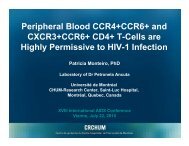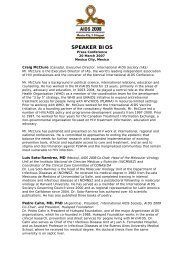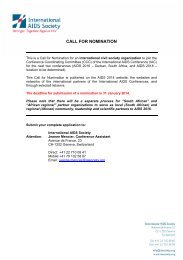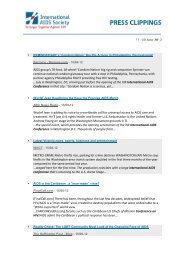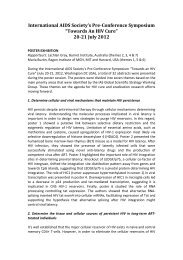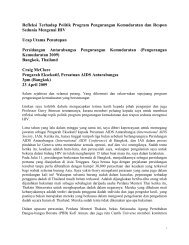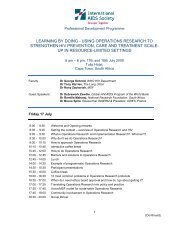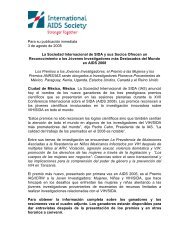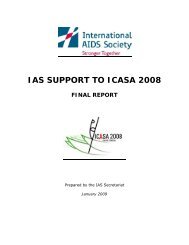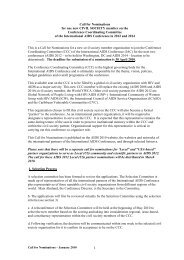Ex vivo modeling of HIV persistence in successfully treated subjects ...
Ex vivo modeling of HIV persistence in successfully treated subjects ...
Ex vivo modeling of HIV persistence in successfully treated subjects ...
You also want an ePaper? Increase the reach of your titles
YUMPU automatically turns print PDFs into web optimized ePapers that Google loves.
“Towards an <strong>HIV</strong> Cure”<br />
Pre-Conference Symposium<br />
20 & 21 July 2012<br />
<strong>Ex</strong> <strong>vivo</strong> <strong>model<strong>in</strong>g</strong> <strong>of</strong> <strong>HIV</strong> <strong>persistence</strong> <strong>in</strong> <strong>successfully</strong><br />
<strong>treated</strong> <strong>subjects</strong>: A powerful tool to evaluate novel<br />
therapeutic eradication strategies<br />
Rémi Froment<strong>in</strong><br />
Vacc<strong>in</strong>e and Gene Therapy Institute-Florida,<br />
Port St Lucie, FL, USA
Evaluative tools for an <strong>HIV</strong> cure<br />
Crucial need to develop powerful tools:<br />
• To test novel therapeutic strategies<br />
• To predict their cl<strong>in</strong>ical outcome<br />
• To evaluate their capacity to elim<strong>in</strong>ate<br />
latently <strong>in</strong>fected cells
• Current methods to study <strong>HIV</strong> latency:<br />
- Cell l<strong>in</strong>es<br />
- Primary human cells (Bosque, Blood 2009; Mar<strong>in</strong>i, JI 2008; Tyagi, JV 2010;<br />
Swiggard, JV 2005; Saleh, Blood 2007; Yang, JCI 2009)<br />
- Cells from virally suppressed <strong>subjects</strong> (Reuse, PLoS One 2009;<br />
Blazkova, JID 2012)<br />
Current tools<br />
• Current assays to measure <strong>HIV</strong> <strong>persistence</strong>:<br />
- <strong>HIV</strong> DNA<br />
- Cell-associated <strong>HIV</strong> RNA<br />
- Co-culture assay (IUPM)<br />
- S<strong>in</strong>gle Copy Assay (SCA)
<strong>HIV</strong> Persistence Detection Assay<br />
“HPDA”<br />
• 5.10 6 CD4 T cells from virally suppressed <strong>subjects</strong><br />
cultured <strong>in</strong> 1mL <strong>of</strong> RPMI 10% FBS + AZT, RAL, EFV<br />
• Harvest half the medium at day 3 and 6<br />
• vRNA RT-qPCR on ultracentifuged supernatants<br />
ARVs<br />
CD4 T cells from virally<br />
suppressed <strong>HIV</strong> <strong>in</strong>fected <strong>subjects</strong><br />
Quantification by RT-qPCR with<br />
a sensitivity <strong>of</strong> 1 <strong>HIV</strong> RNA copy
HPDA: Measur<strong>in</strong>g the <strong>HIV</strong> reservoir size<br />
Viral production<br />
(<strong>HIV</strong> RNA per 10 6 CD4 T cells)<br />
10000<br />
1000<br />
100<br />
10<br />
1<br />
0.1<br />
NS<br />
CD3/CD28<br />
The <strong>HIV</strong> Persistence Detection Assay (HPDA) is sensitive and presents a<br />
wide dynamic range <strong>of</strong> detection.
HPDA: Measur<strong>in</strong>g the <strong>HIV</strong> reservoir size<br />
Viral production<br />
(<strong>HIV</strong> RNA per 10 6 CD4 T cells)<br />
1000<br />
100<br />
10<br />
1<br />
0.1<br />
p=0.05<br />
0 250 500 750 1000 1250<br />
Integrated <strong>HIV</strong> DNA<br />
per 10 6 CD4 T cells<br />
Viral production<br />
(<strong>HIV</strong> RNA per 10 6 CD4 T cells)<br />
10000<br />
1000<br />
100<br />
10<br />
p
HPDA: Measur<strong>in</strong>g the <strong>HIV</strong> reservoir size<br />
<strong>in</strong> tissues<br />
Viral production<br />
(<strong>HIV</strong> RNA per 10 6 CD4 T cells)<br />
100000<br />
10000<br />
1000<br />
100<br />
10<br />
1<br />
A<br />
B<br />
C<br />
Virally suppressed <strong>subjects</strong><br />
Peripheral Blood<br />
Lymph Node<br />
The HPDA allows the measurement <strong>of</strong> the <strong>HIV</strong> reservoir size <strong>in</strong> tissues<br />
from virally suppressed <strong>subjects</strong>.
HPDA: Measur<strong>in</strong>g the <strong>HIV</strong> reservoir size<br />
Assay<br />
qPCR<br />
<strong>HIV</strong> reservoir measured by<br />
Number <strong>of</strong> events<br />
Integrated <strong>HIV</strong> DNA<br />
Pros and cons<br />
+ : Easy, fast, sensitive<br />
- : The majority <strong>of</strong> <strong>in</strong>tegrated<br />
DNA is defective<br />
<strong>HIV</strong> Persistence Detection Assay<br />
ARV<br />
Production competent virus<br />
+ : Relatively easy and fast<br />
+ : Useful to test reactivation<br />
agents<br />
+ : Measure the frequency <strong>of</strong><br />
cells directly targeted by<br />
reactivation strategies<br />
co-culture assay<br />
Allogenic cells<br />
Replication competent virus<br />
- : Laborious and costly<br />
+ : Measure the frequency <strong>of</strong> cells<br />
able to produce <strong>in</strong>fectious particles<br />
responsible for viral rebound at<br />
ART <strong>in</strong>terruption.<br />
+ : Readout for sterilized cure<br />
Cost, labor
HPDA: Identify<strong>in</strong>g reactivation strategies<br />
Reactivation<br />
(% relative to CD3/CD28)<br />
40<br />
30<br />
20<br />
10<br />
0<br />
n=3<br />
Known anti-latency agents:<br />
PKC activators : prostrat<strong>in</strong>, bryostat<strong>in</strong><br />
HDAC <strong>in</strong>hibitors : SAHA, VPA<br />
The HPDA allows the evaluation <strong>of</strong> the ability <strong>of</strong> anti-latency agents to<br />
reactivate virus <strong>in</strong> latently <strong>in</strong>fected cells from virally suppressed <strong>subjects</strong>.
HPDA: Identify<strong>in</strong>g reactivation strategies<br />
Reactivation<br />
(% relative to CD3/CD28)<br />
15<br />
10<br />
5<br />
0<br />
Subject A<br />
10.0<br />
7.5<br />
5.0<br />
2.5<br />
0.0<br />
Subject B<br />
100<br />
75<br />
50<br />
25<br />
0<br />
Subject C<br />
The response <strong>of</strong> latently <strong>in</strong>fected cells to anti-latency agents is highly<br />
variable between virally suppressed <strong>subjects</strong>.
HPDA: Identify<strong>in</strong>g novel antiviral compounds<br />
In addition to viral latency, residual levels <strong>of</strong> <strong>HIV</strong> production may contribute to <strong>HIV</strong><br />
<strong>persistence</strong>.<br />
didehydro-Cortistat<strong>in</strong> A (dCA) = Tat <strong>in</strong>hibitor
HPDA: Identify<strong>in</strong>g novel antiviral compounds<br />
Viral production<br />
(<strong>HIV</strong> RNA copies)<br />
10000<br />
1000<br />
100<br />
10<br />
DMSO<br />
dCA 100nM<br />
1<br />
A B C D<br />
Virally suppressed <strong>subjects</strong><br />
dCA <strong>in</strong>hibits spontaneous viral release from persistently <strong>in</strong>fected cells from virally<br />
suppressed <strong>subjects</strong>.<br />
HPDA allows the evaluation <strong>of</strong> antiviral compounds aimed at affect<strong>in</strong>g ongo<strong>in</strong>g viral<br />
production that persists under HAART.
Conclusions<br />
• Therapeutic strategies aimed at reduc<strong>in</strong>g the size <strong>of</strong> the <strong>HIV</strong><br />
reservoir are likely to differ between <strong>subjects</strong>.<br />
• HPDA allows the identification <strong>of</strong> personalized eradication<br />
strategies.
Conclusions<br />
The <strong>HIV</strong> Persistence Detection Assay:<br />
• Is standardized and easy to perform.<br />
• Uses a relatively low number <strong>of</strong> cells.<br />
• Directly measures the reactivable <strong>HIV</strong> reservoir which is the<br />
target <strong>of</strong> current curative strategies.<br />
HPDA is a simple, accurate and cl<strong>in</strong>ical trial scalable assay to<br />
measure <strong>HIV</strong> <strong>persistence</strong>.
Acknowledgement<br />
Volunteers<br />
Claire Vandergeeten<br />
Mariam Lawani<br />
Sandr<strong>in</strong>a Dafonseca<br />
Rafick-Pierre Sekaly<br />
Nicolas Chomont<br />
Supported by<br />
Susana T Valente<br />
Mike D Miller<br />
Daria Hazuda



